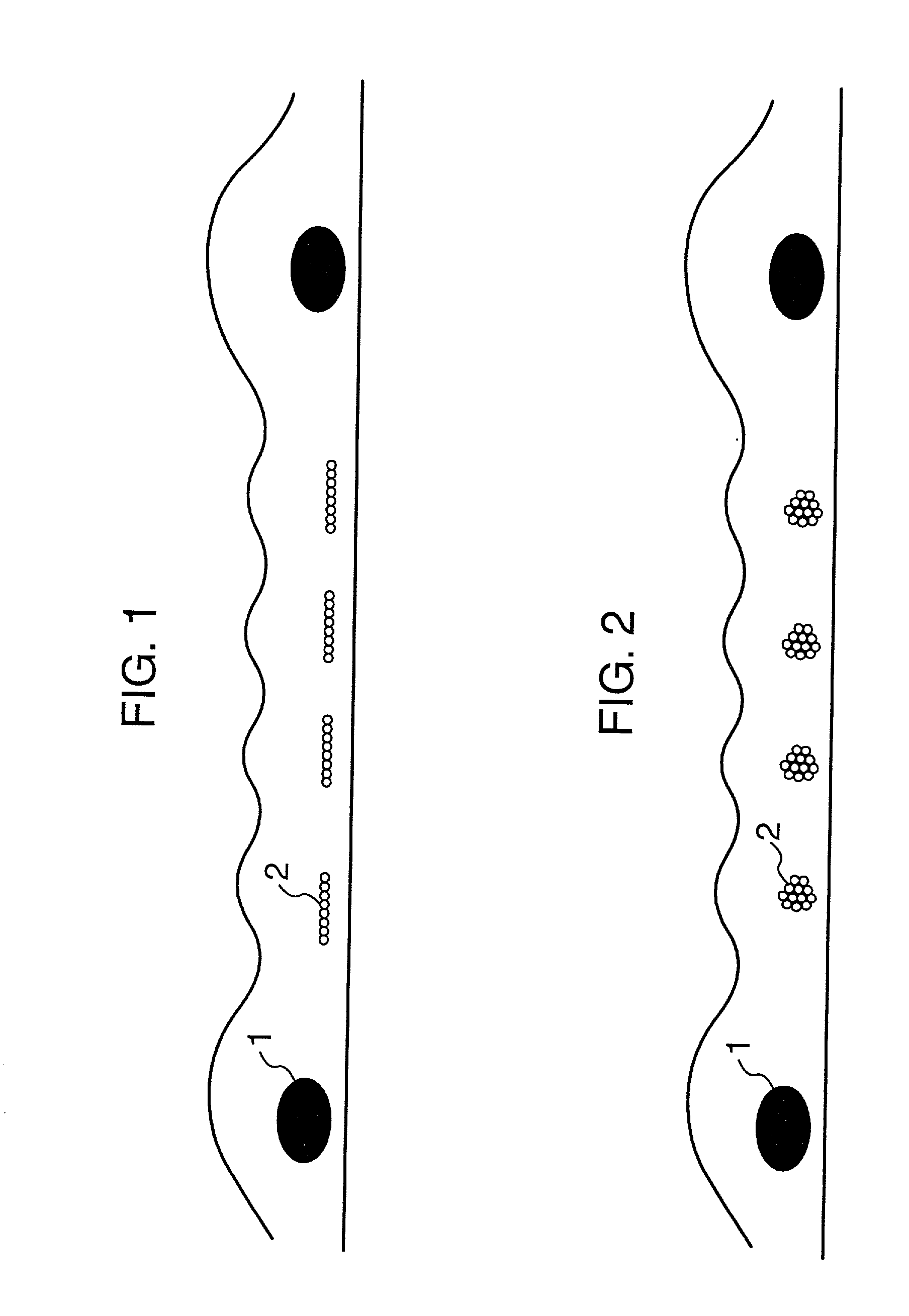Reinforced cation exchange membrane and production process thereof
- Summary
- Abstract
- Description
- Claims
- Application Information
AI Technical Summary
Benefits of technology
Problems solved by technology
Method used
Image
Examples
example 1
[0070] A taped yarn of a polytetrafluoroethylene (PTFE) of 150 denier was twisted at 900 times / m, and was made a filament-like to provide reinforcement threads. A yarn composed of 6 filaments of a polyethylene terephthalate (PET) of 30 denier and a ratio of shrinkage in a boiling water of 8% was twisted at 200 times / m to provide a warp of sacrificial threads. A yarn composed of 8 filaments of a polyethylene terephthalate (PET) of 35 denier and a ratio of shrinkage in a boiling water of 3% was twisted at 10 times / m to provide a weft thereof. By employing these yarns, a plain weave reinforced cloth was weaved so as to have reinforcement threads of PTFE at 16 / inch, and to have sacrificement threads of PET at 64 / inch, i.e. 4 times that of the former. The thickness of the cloth was 100 .mu.m. During the weaving of the cloth, the number of terminations owing to a weft was 55 times / 1000 m, and a fabricating property thereof was favorable.
[0071] After the weaving, the cloth was transferred ...
example 2
[0080] A plain weave reinforced cloth was weaved to obtain a composite membrane in the same way as in Example 1, except that sacrificial threads employed as weft were twisted at 30 times / m. As a result of observing a surface and a cross section of the membrane, a structure was observed wherein the shape of cross sections of almost all sacrificial threads of weft was flat in the direction of the plane of the cloth, and mono-filaments resided in a row without overlapping one another in the direction of thickness of the membrane. During the weaving of the cloth, the number of terminations owing to weft was 43 times / 1000 m, and the weaving property thereof was favorable.
[0081] By using this cloth, a composite membrane was prepared in the same method and conditions as in Example 1. As a result thereof, an openness of the membrane after hydrolysis was 81%. When the membrane was dried and a cross section thereof was observed, all of sacrificial threads were found to be dissolved, and the s...
example 3
[0083] A plain weave reinforced cloth was weaved to obtain a composite membrane in the same way as in Example 1, except that sacrificial threads employed as weft were twisted at 180 times / m. As a result of observing a surface and a cross section of the membrane, a structure was observed wherein the shape of cross sections of almost all sacrificial threads of weft was flat in the direction of the plane of the cloth but a portion of sacrificial threads exhibited a degree of flatness of 1.5. During the weaving of the cloth, the number of terminations owing to weft was 20 times / 1000 m, and the weaving property thereof was very favorable.
[0084] Next, the composite membrane was hydrolyzed in the same method and conditions as in Example 1. As a result thereof, an openness of the membrane was 81%. When the membrane was dried and a cross section thereof was observed, all of sacrificial threads were found to be dissolved, and the shape of channel after dissolution was flat as same as that of ...
PUM
| Property | Measurement | Unit |
|---|---|---|
| Fraction | aaaaa | aaaaa |
| Fraction | aaaaa | aaaaa |
| Linear density | aaaaa | aaaaa |
Abstract
Description
Claims
Application Information
 Login to View More
Login to View More - R&D
- Intellectual Property
- Life Sciences
- Materials
- Tech Scout
- Unparalleled Data Quality
- Higher Quality Content
- 60% Fewer Hallucinations
Browse by: Latest US Patents, China's latest patents, Technical Efficacy Thesaurus, Application Domain, Technology Topic, Popular Technical Reports.
© 2025 PatSnap. All rights reserved.Legal|Privacy policy|Modern Slavery Act Transparency Statement|Sitemap|About US| Contact US: help@patsnap.com



